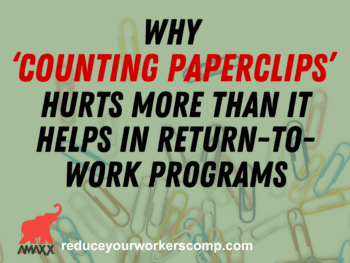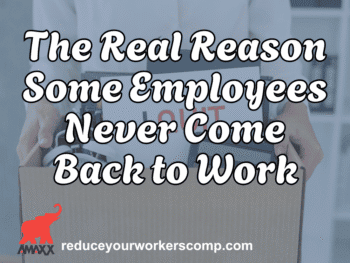
There are many barriers the claims management team must overcome when seeking to return an employee to work following an injury and disability. These barriers include those posed by the employee. Taking a proactive approach to these issues can reduce workers’ compensation costs and boost workplace morale.
Importance of Return-To-Work
Return-to-work is an important aspect of any workers’ compensation claim. This is based on a number of factors:
- Increased spending on medical care and treatment;
- Increased exposure to ongoing wage loss and other benefits, including claims for permanent total disability (PTD) benefits; and
- Costly claims for retraining benefits.
Effective return-to-work starts at the moment an injury occurs. Part of the process includes identifying barriers the employee may raise.
Click Link to Access Free PDF Download
“13 Research Studies to Prove Value of Return-to-Work Program & Gain Stakeholder Buy-In”
Avoiding Medical Issues and De-Conditioning
Employees suffering a work injury are likely to have other co-morbid conditions that prevent a successful return to work. Common ailments include:
- Obesity;
- Learning disabilities;
- Diabetes;
- Drug/alcohol use/abuse; and
According to the National Council on Compensation Insurance (NCCI), there has been a steady increase in the percentage of employees suffering a work-related injury who have a comorbid diagnosis. Some insurance experts estimate nearly 10% of all claims involve this stumbling block.
Proactive members of the claims management team also need to take measures to keep their injured workforce active. Keeping employees active while under restrictions can include:
- Locating sedentary or other light-duty volunteer opportunities;
- Seek non-profit partners in the community who will hire people recovering from work injuries. This partnership is often referred to as a “work on loan” assignment; and
- Providing the employee with a health club membership.
Being creative is key!
Financial burdens, Day Care Challenges and Lack of Transferable Skills
People who suffer from a work-injury face many everyday challenges on a reduced income—even when receiving ongoing wage loss benefits. This is due to the structure of the workers’ compensation system with average weekly wage caps and reduced wages due to statutory payment limits. This results in a challenge for many as they are still faced with financial burdens and familial responsibilities.
Examples of helping injured workers’ through challenging financial times, while at the same time representing the interests of the insured do not necessarily conflict. Claims management teams can assist by developing a database of local and nationwide social services agencies. This can include food shelves, and local human services agencies.
Claims management teams can also encourage their employer clients to investigate services such as “Ticket to Work.” Under this program, persons on SSDI can work for qualifying employers and not receive a reduction of their government benefits. Employers benefit by developing a workforce and receive applicable tax deductions or qualify for certain government contracts.
FREE DOWNLOAD: “13 Research Studies to Prove Value of Return-to-Work Program & Gain Stakeholder Buy-In”
Employee Perceived Work Restrictions
Another barrier that prevents employees from returning to gainful employment is malingering and self-imposed restrictions. This is a challenge every claims handler must overcome at some point in their career. There are many tools one can use to move the employee past this psychological barrier and into the workplace.
- Effective discovery including recorded statements and depositions. It is important to obtain information from the employee about their interests outside of work and what limitations they have when performing those activities.
- Use of Independent Medical Examinations and Independent Vocational Evaluations. IMEs and IVEs are a tool one can use to have the employee seen and examined by an expert. This allows the defense interests to obtain an opinion on the employee’s limitations and physical abilities.
- Use of surveillance. This is a costly method of discovery and should be used with care. When used, a claims handler should consider having the employee subjected to scrutiny over the period of several days and during periods when information suggests they will be outside and engaging in physical activity.
Conclusions
There are many barriers members of the claims management team face when it comes to returning an employee to work, and the employee imposes one of these barriers. It requires the claims handler to be proactive in their approach to reduce future costs on the claim.

Author Michael Stack, CEO Amaxx LLC. He is an expert in workers compensation cost containment systems and helps employers reduce their work comp costs by 20% to 50%. He works as a consultant to large and mid-market clients, is co-author of Your Ultimate Guide To Mastering Workers Comp Costs, a comprehensive step-by-step manual of cost containment strategies based on hands-on field experience, and is founder & lead trainer of Amaxx Workers’ Comp Training Center. .
Contact: mstack@reduceyourworkerscomp.com.
Workers’ Comp Roundup Blog: https://blog.reduceyourworkerscomp.com/
©2017 Amaxx LLC. All rights reserved under International Copyright Law.
Do not use this information without independent verification. All state laws vary. You should consult with your insurance broker, attorney, or qualified professional.















